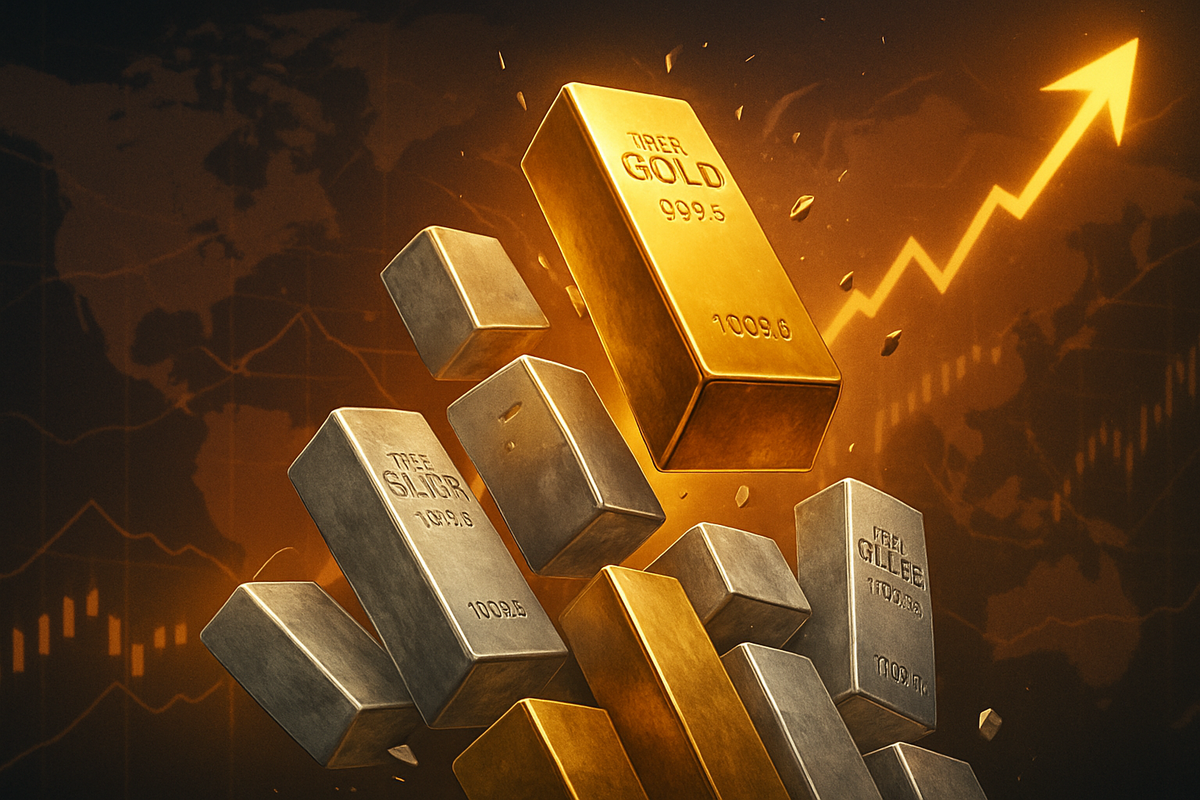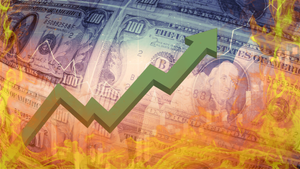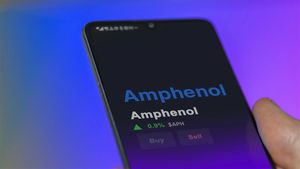
New York, NY – October 8, 2025 – In a monumental shift for the global financial markets, gold has officially breached the unprecedented $4,000 per ounce mark for the first time in history. The precious metal's astounding ascent, driven by a potent cocktail of escalating geopolitical tensions, pervasive economic uncertainty, and growing anticipation of aggressive U.S. interest rate cuts, signals a profound flight to safety among investors worldwide. This historic milestone underscores a period of significant volatility and a re-evaluation of traditional asset classes, with implications set to ripple across industries and national economies.
The yellow metal's meteoric rise is not an isolated event; its sister commodity, silver, is also experiencing a robust surge, outperforming gold in year-to-date gains and reaching its own record highs. This dual rally in precious metals highlights a collective investor sentiment leaning towards tangible assets amidst a landscape fraught with unpredictability. The breaking of the $4,000 barrier for gold is more than just a number; it is a clear indicator of deep-seated concerns regarding the stability of fiat currencies and the broader global economic outlook, forcing market participants to recalibrate their strategies in real-time.
The Unprecedented Ascent: A Detailed Look at Gold's Historic Breakthrough
Gold's journey to $4,000 per ounce has been swift and decisive. As of October 8, 2025, spot gold prices soared to an all-time high of $4,049.59 per ounce, with US gold futures for December delivery closely trailing at $4,037 per troy ounce. This remarkable surge marks a three-day rally that has seen prices add significant value, reflecting intense buying pressure. In the Indian market, 24-carat gold has similarly shattered records, exceeding ₹123,000 per 10 grams and reaching a lifetime high of ₹126,600 in the national capital. This global synchronicity in price appreciation underscores the widespread nature of the driving forces.
The primary catalysts behind this historic rally are multifaceted. Persistent global geopolitical tensions, including a prolonged U.S. government shutdown, have significantly amplified safe-haven demand. Investors, unnerved by political instability and potential conflicts, are increasingly turning to gold as a reliable store of value. Concurrently, mounting concerns about the health of the U.S. economy, coupled with rising inflation expectations, are compelling a shift away from traditional equities and bonds. The belief that the U.S. Federal Reserve is poised to reverse its monetary policy, with anticipated interest rate cuts on the horizon, further bolsters gold's appeal by reducing the opportunity cost of holding the non-yielding asset. Strong physical demand from central banks and retail investors, alongside positive global economic cues, continues to provide a robust floor for prices.
Silver's performance has been equally impressive, closely mirroring gold's upward trajectory and, in some respects, even surpassing it. Spot silver climbed by as much as 3.4%, hitting $49.55 per ounce and notably surpassing its 1980 record high. December silver futures also saw substantial gains, reaching $49.20 per ounce in New York. The Indian market witnessed a significant surge in silver prices, reaching ₹157,000 per kilogram, with some southern cities reporting even higher rates. Beyond its safe-haven appeal, silver benefits from robust industrial demand, particularly from rapidly expanding sectors such as solar panels and electric vehicles, which are contributing to persistent supply deficits. Market tightening, evidenced by rising lease rates and substantial inflows into exchange-traded products, further underscores silver's strong fundamentals.
Market Movers: Winners and Losers in the Golden Age
The unprecedented surge in gold and silver prices creates a distinct bifurcation in the market, producing clear winners and potential losers. Gold and silver mining companies are undoubtedly at the forefront of the beneficiaries. Companies with significant proven reserves and efficient extraction operations stand to see their revenues and profit margins swell dramatically. For instance, major gold producers like Barrick Gold Corp. (NYSE: GOLD) and Newmont Corporation (NYSE: NEM) are likely to experience substantial increases in their stock valuations as their primary commodity commands higher prices. Similarly, silver miners such as Pan American Silver Corp. (NASDAQ: PAAS) and Hecla Mining Company (NYSE: HL) are poised for significant gains, especially given silver's dual role as both a precious and industrial metal. Exploration companies, though higher risk, could also see renewed investor interest and increased funding for new projects.
Conversely, industries and companies heavily reliant on gold or silver as raw materials might face increased cost pressures. Jewelers, for example, will contend with higher input costs, which could impact their profitability or force them to raise consumer prices, potentially dampening demand. Manufacturers of electronic components, solar panels, and other industrial products that utilize silver will also see their material expenses rise, necessitating adjustments in their supply chain management and pricing strategies. Furthermore, investment vehicles that are short on gold or silver, or those that have not diversified into precious metals, may experience underperformance. Central banks holding substantial foreign currency reserves rather than gold might also face questions regarding their asset allocation strategies in an environment where gold is proving to be a superior hedge against inflation and instability.
The ripple effects extend beyond direct producers and consumers. Financial institutions that have significant exposure to precious metals through trading desks or specialized funds are likely to see increased activity and potentially higher fee income. Conversely, those with heavy exposure to more volatile assets or regions grappling with the economic uncertainties driving the gold rally may face headwinds. The overall sentiment shift towards safe-haven assets could also divert capital away from other sectors, potentially impacting growth-oriented companies or those in emerging markets perceived as higher risk.
Broader Implications: A Shift in the Global Financial Landscape
Gold's breach of the $4,000 per ounce barrier is far more than a numerical milestone; it signifies a profound recalibration of the global financial landscape. This event fits squarely into a broader trend of de-dollarization efforts by various nations and a growing distrust in traditional fiat currencies. Central banks globally have been net buyers of gold for years, anticipating such a shift, and this price surge validates their strategic diversification. The sustained high prices of gold and silver could accelerate this trend, prompting more nations to increase their gold reserves, further underpinning demand.
The ripple effects on competitors and partners are significant. For other safe-haven assets like government bonds, particularly those with negative real yields, gold's appeal intensifies, potentially diverting investment flows. Currencies of gold-producing nations, such as Australia and Canada, might experience appreciation due to increased export revenues. Conversely, currencies of nations heavily reliant on commodity imports could face depreciation. Regulatory bodies might also begin scrutinizing the derivatives markets for precious metals more closely, ensuring market stability and preventing excessive speculation. Historically, gold surges have often preceded or accompanied periods of significant economic upheaval or geopolitical realignment, such as the oil crises of the 1970s or the dot-com bubble burst. This current rally, fueled by a confluence of factors, draws parallels to these times, suggesting that the underlying causes are systemic rather than transient.
The event also highlights the increasing importance of alternative investment strategies. As inflation concerns persist and geopolitical risks remain elevated, investors are actively seeking hedges against uncertainty. This could lead to increased interest in other tangible assets, real estate, and even certain cryptocurrencies, though gold and silver retain their historical precedent as ultimate safe havens. The long-term implications for global monetary policy are also substantial; if central banks continue to grapple with inflation and are forced into aggressive rate cuts, the role of gold as an inflation hedge will only strengthen, potentially influencing future policy decisions and international trade dynamics.
What Comes Next: Navigating the Golden Era
The immediate aftermath of gold breaking $4,000 per ounce will likely see continued volatility, but the underlying sentiment suggests further upside potential. In the short-term, technical indicators may signal overbought conditions, leading to minor pullbacks as traders take profits. However, any significant dips are likely to be met with strong buying interest, given the persistent drivers. Analysts are already revising their price targets upwards, with some predicting gold could target $4,200-$4,500 per ounce by early 2026 if current conditions persist or intensify. Silver, with its dual industrial and safe-haven appeal, could see its price continue to outpace gold, potentially reaching $55-$60 per ounce.
Long-term possibilities include gold solidifying its role as the primary global safe-haven asset, potentially challenging the U.S. dollar's dominance in international reserves, especially if the anticipated interest rate cuts by the Federal Reserve are deep and prolonged. This could necessitate strategic pivots for global central banks and sovereign wealth funds, urging them to re-evaluate their asset allocation strategies. Market opportunities will emerge for investors in gold and silver mining equities, precious metals ETFs, and potentially even specialized funds focused on commodities. Challenges include managing the inherent volatility of commodity markets and navigating potential regulatory responses aimed at curbing speculation.
Potential scenarios range from a continued, albeit slower, ascent if geopolitical tensions ease slightly and economic data stabilizes, to an accelerated parabolic rise if global conflicts escalate further or if a severe economic downturn becomes imminent. A "soft landing" for the global economy, combined with controlled interest rate adjustments, might lead to a stabilization of gold prices at these elevated levels, rather than a sharp correction. Conversely, a "hard landing" or an uncontrolled inflationary spiral would almost certainly propel gold to even loftier heights. Investors should prepare for a dynamic market environment where adaptability and a clear understanding of macroeconomic trends will be paramount.
The Dawn of a New Financial Epoch: A Comprehensive Wrap-Up
Gold's historic surge past the $4,000 per ounce mark, coupled with silver's impressive rally, marks a pivotal moment in financial history. The key takeaways from this event are clear: global geopolitical and economic uncertainties are profoundly impacting investor behavior, driving an undeniable flight to safety. The anticipation of U.S. interest rate cuts further reinforces the appeal of non-yielding assets like precious metals, signaling a potential paradigm shift in monetary policy and investment strategy. The market moving forward is likely to be characterized by heightened volatility, but with a strong underlying bullish sentiment for gold and silver, as long as the catalysts remain in play.
This event's lasting impact will be felt across various sectors, from mining companies reaping record profits to industries facing increased input costs. It underscores the fragility of the current economic order and the growing importance of diversification into tangible assets. For investors, the coming months will be crucial. They should closely watch for further developments in geopolitical hotspots, statements from central banks regarding interest rate policy, and key economic indicators such as inflation rates and GDP growth. Monitoring the performance of mining stocks and precious metals-backed ETFs will also provide valuable insights into market sentiment and direction. This new era of elevated precious metals prices demands a cautious yet opportunistic approach, recognizing that the financial landscape has fundamentally shifted.
This content is intended for informational purposes only and is not financial advice






